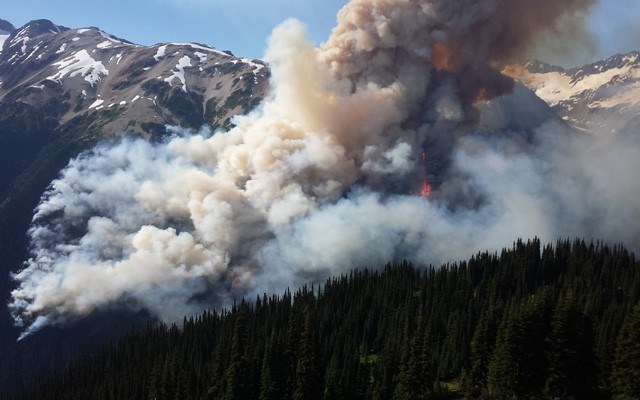If you see smoke on Whistler Mountain on the morning of Thur., June 16, do not be alarmed — what you're seeing is a training exercise for Whistler Blackcomb (WB) staff.
"Probably around 11:30ish or so you'll probably start to see some smoke rising from the Crabapple zone on Whistler Mountain," said Dave McPhee, WB's safety training supervisor.
The Whistler Fire Rescue Service (WFRS) and BC Wildfire Service will be on hand for the controlled burn, which will be about the size of a house and take place below the Crabapple Pump House between 10 a.m. and 12:30 p.m.
"Each year we run a training exercise to prepare our staff just in case there's a wildland fire, so they can become the initial attack to beat it down quickly while waiting for more resources to come," McPhee said, adding that between 30 and 40 employees take the training annually.
"What they do is they put everyone through the S100, which is basically an introduction to how wildland fires start and what's the best way to contain them, control them and put them out."
While there's no reason to be alarmed on the morning of June 16, on any other occasion the public is reminded to call 604-938-FIRE to report fires on WB property.
For other suspected fires, the public is asked to call 911.
"As we get into the fire season, people have to be mindful of no smoking on the mountain, because it's dry and cigarettes are a leading cause of incidental fires," McPhee added.
Thanks to some rainy weather as of late Whistler's current fire danger rating is low, but preparing for a long summer ahead is still top of mind for WFRS chief Geoff Playfair.
Presenting to council on June 7, Playfair outlined some of the actions currently underway to prepare Whistler for the upcoming fire season.
The plans revolve largely around fuel management on public property and employing FireSmart principles on private lots.
"FireSmarting is not going to prevent wildfires, it's going to minimize the impacts, and that's the key," Playfair said.
A Resort Municipality of Whistler FireSmart grant application to the Union of B.C. Municipalities in February failed because it didn't meet the criteria, Playfair told council, but a retooled application had already been pre-approved pending council's approval.
The $10,000 grant will be used to hire a local FireSmart representative who will coordinate with building owners and manage the 2016 neighbourhood program and budget.
The main focus for this year will be on areas identified as high risk in a 2014 assessment — Blueberry Hill, Alpine, Emerald and Spring Creek.
Spring Creek is deemed to be at elevated risk due to only having one road into the subdivision, Playfair said.
"Originally the subdivision was designed to have a second road that connected through to Miller Creek," he said.
"Due to cost, and maybe some other factors, that has never been realized, but the Valley Trail has been maintained as a potential exit out the back of the subdivision if needed. It's not ideal, but it's an option."
Two new pilot projects will help manage the risk this year as well.
The "Adopt a Trail" pilot project is kicking off on the section of Valley Trail between the Whistler Golf Course and Alta Vista.
Fire fighters will be removing fuels in conjunction with municipal staff and the golf course.
"I call this a pilot project because my vision is that we can have that unfold through the Valley Trail throughout the community, with engaged local community groups, perhaps residents or businesses, who want to adopt a piece of the trail and apply some FireSmart principles to that section of trail," Playfair said.
The other pilot project is a wildfire detection robot that will be mounted on top of the Rendezvous restaurant on Blackcomb Mountain.
The robot — produced by Insight Robotics — is essentially a camera on a pole that can detect heat sources in the valley.
"It is linked to a computer and it signals an alert when the camera senses a heat source, and it can sense a tree burning from about eight kilometres away," Playfair said.
"Ultimately it's a free test for us for the summer. Hopefully we'll see some benefit from it, and if so we may consider looking to install some permanent cameras."
The camera provides coverage for about 60 per cent of the valley, Playfair said, while three cameras would provide 100 per cent coverage.
On June 23 from 12:30 to 5:30 p.m. at the Maury Young Arts Centre, the Association of Whistler Area Residents for the Environment is teaming up with the Sea to Sky Clean Air Society to host a Climate Action Symposium on the subject of wildfires.
Titled "Our Future with Forest Fires," the event will feature interactive information displays, informative talks and an après in action.
Speakers include Playfair, fire ecologist Bruce Blackwell, Dr. Sarah Henderson and Scott Shaw Maclaren.
The event will look at mitigation, health impacts, and the future of forest fires and how they might affect us.
For more information, or to buy tickets, head to www.awarewhistler.org.




